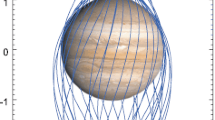Abstract
The future of astronomy in the coming decades will be shaped by the upcoming three extremely large optical telescopes, the Thirty Meter Telescope (TMT), the Giant Magellan Telescope (GMT) and the European Large Telescope (ELT). The USA astronomy and astrophysics 2020 decadal survey and the Canadian long-range plan for astronomy have recently recommended these large observatories as a top priority for ground-based astronomy for the upcoming decade. India is a 10% partner in one of these large observatories, the TMT, which is jointly funded by the Department of Science and Technology (DST) and Department of Atomic Energy (DAE). Here, we highlight India’s contributions to the development of the telescope and science instruments. The size of back-end science instruments scale with telescope aperture, hence, science instruments for TMT will be the biggest ever built for any telescope. Designing and building them requires broad collaboration within India, across TMT partnership and industries. India contributes >30% of the work share towards the development of wide field optical spectrometer (WFOS). India is part of the development of other first-light instruments, the infrared imaging spectrograph (IRIS) and multi-object diffraction-limited high-resolution infrared spectrograph (MODHIS). Infrared guide star catalog is an important contribution from India to these adaptive optics (AO)-assisted instruments. India leads the development of high-resolution optical spectrograph (HROS), a major workhorse among the first decade instruments of TMT. India is also part of the instrument development team of other first-decade instruments. Concerted efforts have been made to contribute to some of the TMT precursor instruments that will help us to maximize the scientific productivity when TMT is operational, especially in the area of exoplanet science and observations that require AO. India-TMT is part of the science team for the Keck high-resolution infrared spectrograph for exoplanet characterization (HISPEC), a precursor instrument to TMT-MODHIS. In addition, Indian Institute of Astrophysics (IIA) is participating in the science and development of Santa Cruz array of lenslets for exoplanet spectroscopy (SCALES) project for Keck, which is a direct imaging spectrograph for exoplanet studies and a precursor to the TMT planetary system imager.











Similar content being viewed by others
References
Anche R. M., Anupama G. C., Reddy K., et al. 2015, SPIE, 9654, 965408. https://doi.org/10.1117/12.2181397
Anche R. M., Sen A. K., Anupama G. C., et al. 2018a, Journal of Astronomical Telescopes, Instruments and Systems, 4, 018003. https://doi.org/10.1117/1.JATIS.4.1.018003
Anche R. M., Packham C., Anupama G. C., et al. 2018b, SPIE, 10702, 1070298. https://doi.org/10.1117/12.2312558
Boyer C. 2018, SPIE, 10703, 107030Y. https://doi.org/10.1117/12.2313753
Crane J., Atwood J., Andersen D., et al. 2018, SPIE, 10703, 107033L. https://doi.org/10.1117/12.2314312
Ellerbroek B. L. 2013, Journal of Astrophysics and Astronomy, 34, 121. https://doi.org/10.1007/s12036-013-9171-y
Fanson J., Bernstein R., Angeli G., et al. 2020, SPIE, 11445, 114451F. https://doi.org/10.1117/12.2561852
Ishwara-Chandra C. H. 2013, Journal of Astrophysics and Astronomy, 34, 141. https://doi.org/10.1007/s12036-013-9179-3
Larkin J. E., Wright S. A., Chisholm E. M., et al. 2020, SPIE, 11447, 114471Y. https://doi.org/10.1117/12.2561184
Pandey S. B. 2013, Journal of Astrophysics and Astronomy, 34, 157. https://doi.org/10.1007/s12036-013-9178-4
Reddy B. E. 2013, Journal of Astrophysics and Astronomy, 34, 87. https://doi.org/10.1007/s12036-013-9180-x
Sanders G. H. 2013, Journal of Astrophysics and Astronomy, 34, 81. https://doi.org/10.1007/s12036-013-9169-5
Sengupta S. 2013, Journal of Astrophysics and Astronomy, 34, 151. https://doi.org/10.1007/s12036-013-9170-z
Simard L. 2013, Journal of Astrophysics and Astronomy, 34, 97. https://doi.org/10.1007/s12036-013-9177-5
Skidmore W., TMT International Science Development Teams, Science Advisory Committee T. 2015, Research in Astronomy and Astrophysics, 15, 1945. https://doi.org/10.1088/1674-4527/15/12/001
Subramanian S., Subramaniam A., Simard L., et al. 2013, Journal of Astrophysics and Astronomy, 34, 175. https://doi.org/10.1007/s12036-013-9176-6
Subramanian S., Subramaniam A., Sivarani T., et al. 2016, Journal of Astrophysics and Astronomy, 37, 24. https://doi.org/10.1007/s12036-016-9401-1
Surya A., Zonca A., Rundquist N. E., et al. 2020, SPIE, 11452, 114521K. https://doi.org/10.1117/12.2561766
Wright S. A., Walth G., Do T., et al. 2016, SPIE, 9909, 990905. https://doi.org/10.1117/12.2233182
Wright, S. A., Larkin J. E., Moore A. M., et al. 2014, SPIE, 9147, 91479S. https://doi.org/10.1117/12.2055599
Acknowledgements
The TMT international observatory LLC (TIO), a non-profit organization, was established in May 2014 to carry out the construction and operation phases of the TMT Project. The members of the TIO are Caltech, the University of California, the National Institutes of Natural Sciences of Japan, the National Astronomical Observatories of the Chinese Academy of Sciences, the Department of Science and Technology of India and the National Research Council (Canada); and the Association of Universities for Research in Astronomy (AURA) is a TIO Associate. Major funding has been provided by the Gordon & Betty Moore Foundation.
Author information
Authors and Affiliations
Corresponding author
Additional information
This article is part of the Special Issue on “Astrophysical Jets and Observational Facilities: A National Perspective”.
Rights and permissions
About this article
Cite this article
Sivarani, T., Sethuram, R., Sriram, S. et al. India-TMT project—science instrumentation program. J Astrophys Astron 43, 86 (2022). https://doi.org/10.1007/s12036-022-09867-y
Received:
Accepted:
Published:
DOI: https://doi.org/10.1007/s12036-022-09867-y




